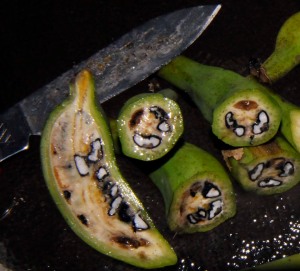
Crop relatives are important – we learn about the relationships of wild germplasm in comparison to the domesticated forms, and about the genetics and genes in the wild species. Two papers in the last month advance our understanding of wild banana (Musa) from different perspectives.
The first presents “A draft Musa balbisiana genome sequence for molecular genetics in polyploid, inter- and intra-specific Musa hybrids.” and is by Mark W. Davey, Ranganath Gudimella, Jennifer Ann Harikrishna, Lee Wan Sin, Norzulaani Khalid and Wannes Keulemans in BMC Genomics 2013, 14:683 doi:10.1186/1471-2164-14-683 . http://www.biomedcentral.com/1471-2164/14/683/abstract
As Mark Davey says, this is the first report of the annotated genome of Musa balbisiana, a set of de novo assembled gDNA contigs, as well as predicted CDS, protein lists, SSRs, genome wide SNPs, and microRNA families from this wild banana species. It is also terrific that the sequence data is publicly accessible in the excellent Banana Genome Hub Website, coordinated by Mathieu Rouard: see http://banana-genome.cirad.fr/cgi-bin/gbrowse/musa_balbisiana_pkw/ to view and search sequence directly or http://banana-genome.cirad.fr/content/musa-balbisiana-pisang-klutuk-wulung to download.
The second paper by Markku Häkkinen revises the taxonomy of the genus: Musa is formally subdivided into two sections, the Musa section with x=11 chromosomes, and the Callimusa section with x=10 (and a couple of species x=7 and 9). The contents of the paper are summarized on the Promusa website, and Anne Vézina from Bioversity gives an excellent overview of the taxonomic changes in her blog – http://www.promusa.org/tiki-view_blog_post.php?postId=312. She also covers the breeding potential of using the genepool in the old Rhodochlamys section, now part of section Musa. Markku concludes his paper with some important points: “Beyond this revised sectional classification, the infrageneric taxonomy of Musa could be further clarified from additional phylogenetic studies that have a broader sampling of species. Much of the diversity in the two sections is found in areas of continental Asia that have been, and continue to be, difficult, and sometimes even dangerous, to travel and work in. There are still new Musa species observed by the author in those areas awaiting description or clarification.”
(Although correct in nomenclature terms, I’m less happy with the section Musa having the same name as the genus Musa – meaning you will very often need to add the word ‘genus’ or ‘section’ before the name to make it clear which taxonomic level you are talking about.)
Davey MW, Gudimella R, Harikrishna JA, Sin LW, Khalid N, Keulemans J. “A draft Musa balbisiana genome sequence for molecular genetics in polyploid, inter- and intra-specific Musa hybrids”. BMC Genomics. 2013;14(1):683.
Modern banana cultivars are primarily interspecific triploid hybrids of two species, Musa acuminata and Musa balbisiana, which respectively contribute the A- and B-genomes. The M. balbisiana genome has been associated with improved vigour and tolerance to biotic and abiotic stresses and is thus a target for Musa breeding programs. However, while a reference M. acuminata genome has recently been released [1], little sequence data is available for the corresponding B-genome.
To address these problems we carried out Next Generation gDNA sequencing of the wild diploid M. balbisiana variety ‘Pisang Klutuk Wulung’ (PKW). Our strategy was to align PKW gDNA reads against the published A-genome and to extract the mapped consensus sequences for subsequent rounds of evaluation and gene annotation. The resulting B-genome is 79% the size of the A-genome, and contains 36,638 predicted functional gene sequences which is nearly identical to the 36,542 of the A-genome. There is substantial sequence divergence from the A-genome at a frequency of 1 homozygous SNP per 23.1 bp, and a high degree of heterozygosity corresponding to one heterozygous SNP per 55.9 bp. Using expressed small RNA data, a similar number of microRNA sequences were predicted in both A- and B-genomes, but additional novel miRNAs were detected, including some that are unique to each genome. The usefulness of this B-genome sequence was evaluated by mapping RNA-seq data from a set of triploid AAA and AAB hybrids simultaneously to both genomes. Results for the plantains demonstrated the expected 2:1 distribution of reads across the A- and B-genomes, but for the AAA genomes, results show they contain regions of significant homology to the B-genome supporting proposals that there has been a history of interspecific recombination between homeologous A and B chromosomes in Musa hybrids.
Conclusions:
We have generated and annotated a draft reference Musa B-genome and demonstrate that this can be used for molecular genetic mapping of gene transcripts and small RNA expression data from several allopolyploid banana cultivars. This draft therefore represents a valuable resource to support the study of metabolism in inter- and intraspecific triploid Musa hybrids and to help direct breeding programs.
 Häkkinen, Markku, 2013. Reappraisal of sectional taxonomy in Musa (Musaceae). Taxon 62(4), 21 August 2013 , pp. 809-813(5) (paper publisher link £££). http://dx.doi.org/10.12705/624.3
Häkkinen, Markku, 2013. Reappraisal of sectional taxonomy in Musa (Musaceae). Taxon 62(4), 21 August 2013 , pp. 809-813(5) (paper publisher link £££). http://dx.doi.org/10.12705/624.3
Abstract: The present work is part of a continuing study on Musa taxa by the author. Several molecular analyses support acceptance of only two Musa sections, M. sect. Musa and M. sect. Callimusa. Musa sect. Rhodochlamys is synonymized with M. sect. Musa and M. sect. Australimusa and M. sect. Ingentimusa are treated as synonyms of M. sect. Callimusa. Species lists are provided for the two accepted sections.
Intranet UoL subscription (Password required) Hakkinen_TaxonomyRevision2SectionsMusa

Nice to see banana work thriving,…best wishes
A
Informative t researchers working on banana genome
Cool – I’veread the major commercial variety is suffering a disease attack and we may all be soon eating a different variety when we buy from Dole (or other big sellers)